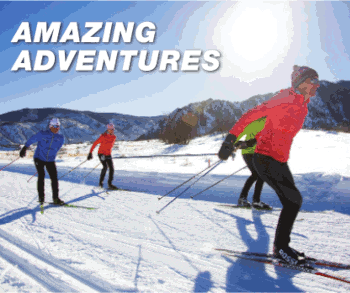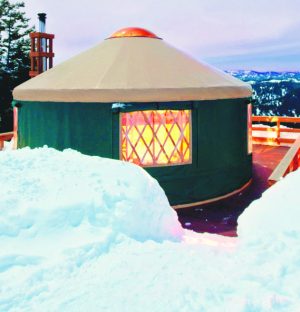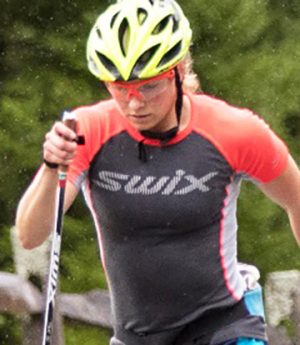July 2, 2007 (Park City, Utah) – Ski Jumpers Alan Alborn (Anchorage, AK) and Clint Jones (Steamboat Springs, CO), Olympic teammates and former U.S. champions, have retired from World Cup competition.
However, Alborn, a three-time Olympian who holds the U.S. jumping distance record, and two-time Olympic jumper Jones didn’t waste any time in retirement. The pair, who also competed in four FIS Nordic World Ski Championships apiece, are the new elite (Alborn) and development (Jones) coaches for the Park City-based National Sports Foundation; they plan to be activists in helping revamp the nation’s jumping pipeline, they said.
Jones, 22, was the youngest U.S. gold medalist when he won the large hill title at 15 in 2000. He said, “This is a great opportunity. It’s a chance for Alan and I to take a step back and, with all we’ve learned, help younger kids start from scratch.”
Alborn, 26, and getting married this fall, added, “It’s a great feeling to be offered a job right away because it’s always an issue for jumpers trying to find jobs after retirement. The timing worked out great.”
A five-time U.S. jumping champion, he was troubled with knee problems in the last few years although he set the U.S. distance record of 221.5 meters at Planica, Slovenia, in 2002, topping his then-record of 211 meters. In that ’02 season, Alborn also had a fourth- and two sixth-place World Cup results, and swept both the normal hill and large hill U.S. championships.
Competing ends, preparing others begins
“It’s a big, double whammy when your top two athletes – as they have been for many years – retire,” U.S. Nordic Director Luke Bodensteiner said. “However, this is so valuable for us and for the jumping community to have them continue in the sport as coaches. They have strong ideas on what needs to get done – especially in terms of preparing athletes for international competition – and they’re showing good leadership by staying in their sport and looking to help things improve.”
Alborn started jumping with the Karl Eid program in Anchorage and, he said, “loved it. Then, when my father [a commercial pilot] was transferred to Colorado, I got to train with the Steamboat Springs Winter Sports Club for three years. Otherwise, I probably would have been twiddling my thumbs in Anchorage, jumping off the 50-meter [jump] and wondering about what it would be like to be in the Olympics.”
He spent seven years on the U.S. Ski Team, retiring after the 2003 season but coming back a year later because he missed the sport, and because his knees felt fine.
“I’ve learned so much more than I would have thought, and the travel and the perspective that the Ski Team gave me are invaluable. I feel I owe the Team something I can’t pay back. There have been ups and downs, but if I had to do it all over again, for sure I’d do it,” Alborn said.
Alborn recalls record jump
Looking back to his long jump during the qualifying round in Planica in ’02, Alborn called it “an amazing jump although, unfortunately, the competition was blown out [by high winds]. I can’t imagine what would have happened if we’d held it. I had such a good feeling…knew immediately on leaving the takeoff I’d done it. I had this weightless feeling over the knoll because I was so balanced coming down the in-run.
“I felt like a knife slicing through the air and it took me right to the bottom of the hill. It seemed like 30 minutes because I was flying so effortlessly. I could see people on the side of the hill cheering. One thing,” he added, “is I wish I had tried to keep flying a little longer; the record was 225 meters, and if they had a line [in the snow] past 225 and…well, who knows?
“I remember, though, yelling to myself going over the knoll at 140 meters, pushing myself to push the limit. I hope somebody else can feel that.”
Jones, also a seven-year Ski Team member, came out of the Steamboat Springs Winter Sports Club jumping program, too. He credits Chris Gilbertson, currently the Continental Cup coach for the U.S. Nordic Combined Team, for giving him a good foundation.
He had his best World Cup results in Finland, including a ninth and 12th in Kuopio and 13th in Kuusamo. “I don’t know what it was,” Jones said, “but we spent a lot of time in Finland with Kari [Ylianttila, U.S. head coach 1998-2004 and former Finnish head coach], so Finland was like a second home to us. I always felt comfortable over there.
“You learn a lot of things…”
“But, when it’s all done, you forget about things like results. I got to see a lot of cool places, meet a lot of cool people. And, at that level, you learn a lot of things about yourself and life in general,” Jones said. “I’m very happy with the way things went, and now there are other things I want to do with my life,” he said. He plans to enroll in college at some point, but for the present, coaching is his top priority.
Alborn and Jones have been working for the past month with the National Sports Foundation skiers, mixing strength training with the jumping. They created a strength training area at the top of the Utah Olympic Park jumps to boost their overall conditioning.
“These kids are like sponges. We’ve seen some pretty good stuff,” Alborn said, “and some not-so-good. But that’s the challenge, and that’s part of the reward. Clint and I both feel we’ve got something to offer young jumpers, and if we accomplish that, it’ll be a good thing.
“Being a [new] coach will take a while for me to be accepted in the coaching community and respected, I’m sure. That’s fine. I understand that. Clint understands it, too. We’ve talked with Luke [Bodensteiner] about our thoughts, about preparing these kids…not just sending them to competitions in Europe or Japan because we want someone there. There’s so much preparation that needs to be done, and the international comps will come in time…but not necessarily now…
“It’s a question of how good a jumper do you want to produce, a national champion or a world champion? There’s a lot of work to be done,” Alborn said.
Jones: “…true athletes, not just on paper”
Jones agreed. “We want to make the athletes into true athletes, not just on paper,” he said. “We’ve got a lot of experience, a lot of things to draw from, different coaches, and all that…and just look at what the cross country team has done in the last few years, reviving that program. We can do it, too. We need to be organized and work hard – that’s no secret…
“I remember when I was 12 years old, back when you weren’t thinking about making a team or going to a certain competition. You were just trying to get better. That was exciting, definitely cool…and jumping’s still definitely cool.”
Each sees the need for a national standard for jumping. “We need to get everyone on the same page in terms of development; kids in the East are different from the Midwest, and then Steamboat and NSF may be different from everyone else. So, it’s challenge but there’s no question we need to have some uniformity and structure in what we’re all coaching…and then get these young athletes moving up through the pipeline, not just have ’em floating around,” Jones said.
Bodensteiner is pleased with their approach. “It’s so valuable to have these guys in the field and focusing on preparation. We need to get kids better prepared to compete rather than just having them participating.
“The jumping community understands the problem. There’s no quick turn-around but getting organized is the first step. And what Alan and Clint can bring to this is the fact they’re current with what’s happening and they’re fired up to make a major impact on their sport. On one hand, it’s tough to see them retire, but on the other hand they bring such good, positive energy to the situation…and they’ll make that positive impact.”
Top News Stories
USA’s Olympic Jumpers Alborn and Jones Retire
release by USSALeave a Reply
You must be logged in to post a comment.






![National camp action [P]...](https://skitrax.com/wp-content/uploads/2019/08/Duluth-4-2019-08-08-at-10.46.51-AM-300x246.png)
![Matt Liebsch on the CXC Elite Team [P] CXC...](https://skitrax.com/wp-content/uploads/2019/08/Matt-Liebsch-CXC.2-525x700.4-300x267.jpg)
![Dan LaBlanc [P]...](https://skitrax.com/wp-content/uploads/2019/08/Dan-LaBlanc-img_1855.3.jpg)
